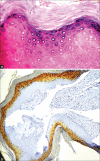Loricrin - an overview
- PMID: 26097310
- PMCID: PMC4451671
- DOI: 10.4103/0973-029X.157204
Loricrin - an overview
Abstract
Loricrin is a terminally differentiating structural protein comprising more than 70% of the cornified envelope. It contributes to the protective barrier function of the stratum corneum. In vivo, loricrin is expressed inall mammalian stratified epithelia with the highest levels of expression in humid tissues such as newborn epidermis, the epithelia of oral and anal mucosa, esophagus, foreskin, vagina and the epidermal parts of sweat ducts. Loricrin is not expressed in non keratinizing epithelia and its expression at these sites actually represents a defensive or protective mechanismof the body. An insight into this protein- "Loricrin" can shed light to its potential as a marker in the early stages of potentially malignant disorders like oral sub mucous fibrosis and leukoplakia. This compilation has been done by taking into account the existing literature, reviews and original studies on loricrin, a major component of the cornifiedcell envelope, its structure and the alterations that result due to its absence or presence of both the epidermis and the oral mucosa.
Keywords: Cornified cell envelope; loricrin; loricrin keratoderma; oral sub mucous fibrosis.
Conflict of interest statement
Figures

References
-
- Presland RB, Jurevic RJ. Making sense of the epithelial barrier: What molecular biology and genetics tell us about the functions of oral mucosal and epidermal tissues. J Dent Educ. 2002;66:564–74. - PubMed
-
- Fuchs E. Keratins and the skin. Annu Rev Cell Dev Biol. 1995;11:123–53. - PubMed
-
- Nemes Z, Steinert PM. Bricks and mortar of the epidermal barrier. Exp Mol Med. 1999;31:5–19. - PubMed
-
- Ishida-Yamamoto A, Takahashi H, Lizuka H. Immunoelectron microscopy links molecules and morphology in the studies of keratinisation. Eur J Dermatol. 2000;10:429–35. - PubMed
-
- Yoneda K, Hohl D, McBride OW, Wang M, Cehrs KU, Idler WW, et al. The human loricrin gene. J Biol Chem. 1992;267:18060–6. - PubMed

